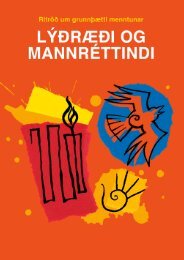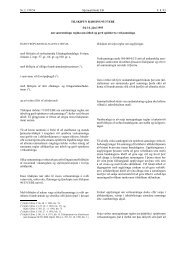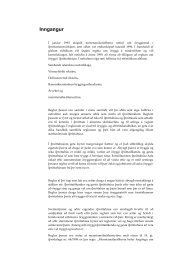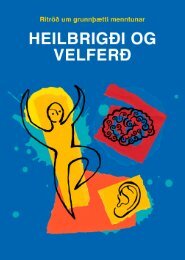Arts and Cultural Education in Iceland : Professor Anne Bamford
Arts and Cultural Education in Iceland : Professor Anne Bamford
Arts and Cultural Education in Iceland : Professor Anne Bamford
Create successful ePaper yourself
Turn your PDF publications into a flip-book with our unique Google optimized e-Paper software.
high school <strong>and</strong> with the various organisations engaged <strong>in</strong> higher <strong>and</strong> further<br />
education<br />
‣ With a few exceptions, the role of cultural <strong>in</strong>stitutions <strong>in</strong> promot<strong>in</strong>g <strong>and</strong> exp<strong>and</strong><strong>in</strong>g<br />
arts education <strong>in</strong> schools is largely under developed.<br />
Active partnership <strong>in</strong>volves the direct <strong>in</strong>clusion of a range of cultural <strong>and</strong> artistic<br />
organizations <strong>in</strong> the plann<strong>in</strong>g <strong>and</strong> delivery of arts education programmes <strong>in</strong> schools. The most<br />
effective programmes have managed to build susta<strong>in</strong>able, long-term <strong>and</strong> reciprocal associations<br />
with cultural agencies <strong>and</strong> <strong>in</strong>dustries.<br />
Countries that have effective arts <strong>and</strong> cultural education generally have active partnerships<br />
across sectors, discipl<strong>in</strong>es <strong>and</strong> organisations. The notion of an active partnership <strong>in</strong>volves the<br />
direct <strong>in</strong>clusion of a range of cultural <strong>and</strong> artistic organizations <strong>in</strong> all aspects of the plann<strong>in</strong>g <strong>and</strong><br />
delivery. The best of these provide susta<strong>in</strong>able, long-term <strong>and</strong> reciprocal associations. These<br />
susta<strong>in</strong>ed associations are centred on shared responsibility for plann<strong>in</strong>g, implement<strong>in</strong>g <strong>and</strong><br />
evaluat<strong>in</strong>g programmes.<br />
While the most common partnerships <strong>in</strong> a world context are between the cultural <strong>and</strong><br />
educational sectors, a number of countries have a range of agencies support<strong>in</strong>g arts education<br />
<strong>in</strong>clud<strong>in</strong>g private <strong>in</strong>dividuals (the most common one), enterprise, the community, trade unions<br />
<strong>and</strong> a number of other possible partnerships. These partnerships tend to encourage the pool<strong>in</strong>g<br />
of f<strong>in</strong>ancial resources, human resources <strong>and</strong> expertise to produce substantial arts education<br />
programmes.<br />
The <strong>in</strong>ternational research suggests that successful partnerships are susta<strong>in</strong>ed <strong>and</strong> <strong>in</strong>volve<br />
shared responsibility for plann<strong>in</strong>g <strong>and</strong> evaluation. This is generally not the case <strong>in</strong> Icel<strong>and</strong>, where<br />
professional artists tend to come <strong>in</strong>to the school for short-term ‘special projects’ or for schoolbased<br />
performances rather than as a susta<strong>in</strong>ed part of curriculum implementation. This tends to<br />
be an isolated experience, as this comment emphasises; “I have a background <strong>in</strong> theatre <strong>and</strong> I<br />
work with a lot of schools <strong>in</strong> the area of drama, I travel between schools <strong>and</strong> I am completely<br />
self-sufficient <strong>and</strong> st<strong>and</strong> alone, it really doesn’t connect with what’s happen<strong>in</strong>g <strong>in</strong> the schools”<br />
(artist <strong>in</strong> school).<br />
The exception to this was music, where some music schools worked actively with<strong>in</strong> the<br />
school. Also, by chance rather than plann<strong>in</strong>g, a shortage of teachers <strong>in</strong> textiles, design <strong>and</strong><br />
woodcraft mean that these areas may be taught by <strong>in</strong>dustry professionals. Special occasions,<br />
such as festivals <strong>and</strong> performances also provided opportunities for partnership work<strong>in</strong>g. For<br />
example several schools employed professional directors, composers <strong>and</strong> musicians to guide<br />
preparations for school performances. This can be seen <strong>in</strong> Figure 3.2.1 where music schools are<br />
the most common collaborator with the compulsory school.<br />
54


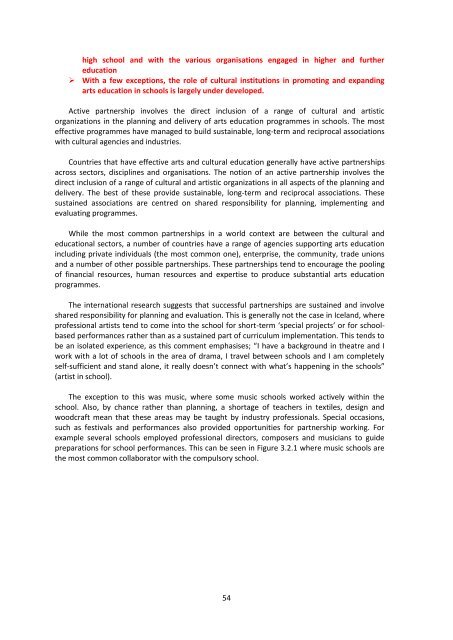
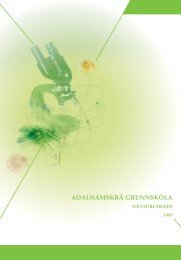
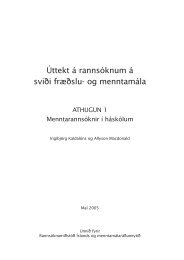

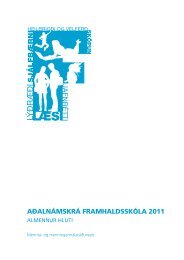
![Aðalnámskrá tónlistarskóla : rytmÃsk tónlist [Eingöngu á rafrænu formi]](https://img.yumpu.com/50843672/1/184x260/aaalnamskra-tanlistarskala-rytma-sk-tanlist-eingangu-a-rafranu-formi.jpg?quality=85)
